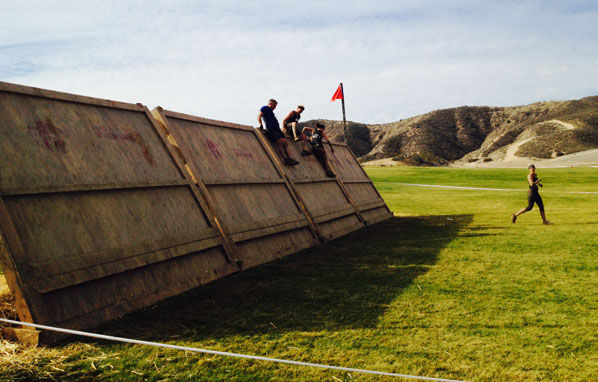Wading through chest-high water, running up muddy hills, climbing over walls, swinging on monkey bars and crawling through mud might seem like challenges for soldiers in basic training, but these are just a few examples of obstacles from popular racing events that have significantly changed the recreational fitness landscape over the past few years. While standard running distances like 5 kilometers (3.2 miles), 10 kilometers (6.4 miles), or a 26.2 mile marathon primarily challenge aerobic endurance, obstacle course races provide a greater fitness challenge by requiring upper-body strength combined with anaerobic power. Individuals who exercise frequently and value physical activity as part of a healthy lifestyle also enjoy testing themselves with demanding fitness challenges. For many, completing a challenging obstacle course provides a sense of accomplishment that traditional running races can’t offer.
What is an Obstacle Course Race?
An “obstacle course race” is a generic term for a type of running race that has exploded in popularity in recent years. A typical obstacle course run can range from 5 kilometers (3.2 miles) to 10+ miles in length and feature numerous obstacles like mud pits, ice baths, tunnels, walls or even the occasional fire pit. Events such as Warrior Dash, Spartan Race and Tough Mudder are examples of races with specific themes and specially designed obstacles. Fans of AMC’s The Walking Dead can even sign up for races that require participants to dodge zombies while running an obstacle course. Creative people with an artistic bent can participate in color runs, where participants wear all white and are splashed with vibrant colors between the start and the finish of the run. The Boot Camp Challenge at the Marine Corps Recruit Training Depot in San Diego allows participants to run a scaled-down version of the obstacle course used in basic training, with verbal “encouragement” offered by real Marine Corps drill instructors.
For adults who played competitive team sports up to and through college it can be tough to find the same sort of athletic challenge once they’ve entered the professional working world. Obstacle course races provide a worthy athletic outlet because athleticism and strength are required to successfully overcome many challenging obstacles. This allows for the emergence of an inner warrior not easily expressed at home or in the workplace. Training for and participating in obstacle course races also allows competitive individuals to have the experience of a challenging competition without the logistics of committing to a team practice or an extensive game schedule. In many races, participants are encouraged to support and help one another; for example, the Tough Mudder events are not timed and the start includes an oath that encourages participants to work together to overcome the obstacles and achieve success.
Marketing Opportunity
If you are looking for unique ways to market your personal-training services or boot camp, it might be a good idea to offer a conditioning program to help individuals train for an upcoming obstacle course race in your area. Registration for races includes both individual and group options, making them a perfect opportunity to design a small-group training program. Training for a challenging goal in a group environment can develop friendships, which can help an individual participant develop the self-efficacy to establish adherence to regular exercise.
If you want to use an upcoming event as an opportunity to promote your fitness business, start by researching events in your area. Make sure that you pick one that is an appropriate skill level for your participants. Keep in mind that some obstacle course events feature obstacles that are difficult and could cause extreme injury if done improperly. (Although events don’t require participants to do the obstacles and offer ways around them, it can be easy for a participant to get caught up in the moment and try something above his or her skill level.)
Obstacle course race training involves more than just running. Many obstacles require participants to have the upper-body strength to lift their own body weight, the coordination to climb over walls and the flexibility to low-crawl through tunnels or under barbed wire (seriously). Most races will list the majority of the obstacles online, leaving room for a few surprises on race day. Another factor is that some obstacles will require teamwork to overcome, making it important to include various partner and group drills in the training program. Review the race course and then design a workout program to prepare participants for the demands of the competition. Most event websites list training tips for how to prepare for the race; however, if you want to brush up on ideas to create a progressively challenging conditioning program, it might be helpful to check out the ACE Sports Conditioning workshop to learn how to design energy system-specific exercise programs.
Planning a Conditioning Program

The Tough Mudder series feature courses with approximately 25 obstacles spread out over 10 to 12 miles (due to the variability of the event venues it can be difficult to have the exact same course at each different location). This means that a participant can expect to perform one obstacle about every 0.5 mile or approximately 1 kilometer (0.6 miles). If participants are expected to overcome an obstacle every 1 kilometer or so, it becomes more important to emphasize high-intensity intervals for running as opposed to the long, slow distance training typically performed for endurance events.
A combination of climbing over obstacles and running at high bursts of speed requires the ability to work at an intensity near the second ventilatory threshold (VT2,) commonly referred to as the onset of blood lactate (OBLA). To prepare for the specific metabolic challenges, an obstacle course race training program should alternate between circuits of three to five strength exercises, with minimal rest periods between each exercise, and bouts of high-speed running following a high-intensity interval training (HIIT) protocol.
The following sample workout demonstrates how to use strength training combined with HIIT running intervals to prepare for an obstacle course race. Other training options include using equipment like heavy medicine balls, weight sleds, heavy tires, stair running and sandbags. The idea is to create dynamic and unstable loads to prepare the body for the challenges it will face during the event. As with any training program, ensure that the exercises are the appropriate skill level and intensity for your participants and offer modifications when necessary.
Sample Workout to Prepare for an Obstacle Course Race
|
Exercise |
Intensity |
Work Interval |
Warm-up:
|
Plank |
Bodyweight |
30 sec. |
- Recovery Interval: 1 min after circuit
- Repetitions: Perform BW exercises as a circuit – 2-3 times
Perform jogging drills as a circuit – 2-3 times
Strength Circuit 1:
|
TRX Push-ups |
BW |
45 sec. |
- Recovery Interval: 90 seconds after circuit
- Repetitions: 2-3 circuits
Running Drills:
|
80 meter sprints |
High |
10-15 sec. |
- Recovery Interval: 30-45 sec.
- Repetitions: 5
Strength Circuit 2:
|
Medicine ball lunge to chest pass |
3-5 Kg |
Each 45 sec. |
- Recovery Interval: 90 seconds after circuit
- Repetitions: 2-3 circuits
Running Drills:
|
90 meter shuttle run |
Hard |
20-25 sec. |
- Recovery Interval: 30-60 sec., 60-90 sec. & 10-15 sec.
- Repetitions: 5, 5 & 8
Cool Down / Stretching:
|
Each 30 sec. |
- Recovery Interval:
- Repetitions: Each 1-2




 by
by 









 by
by